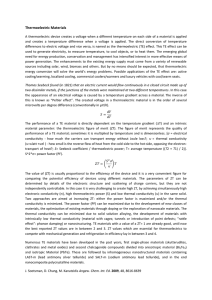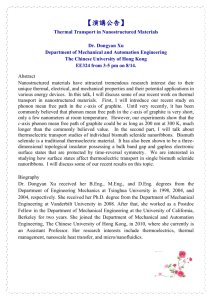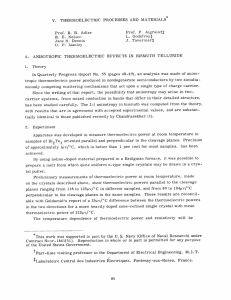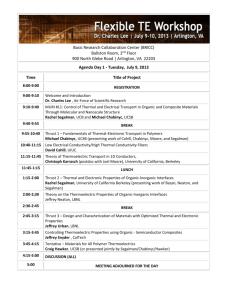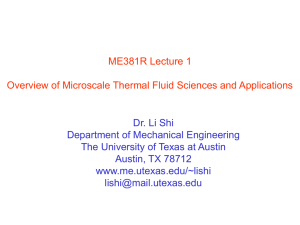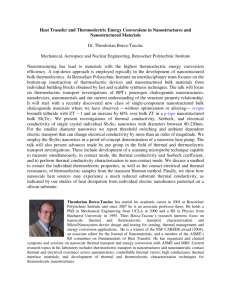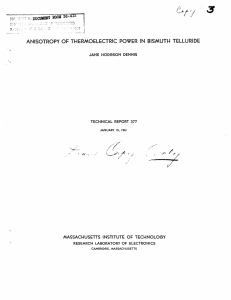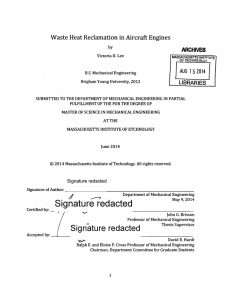III. PROCESSES Prof. R. B. Adler
advertisement
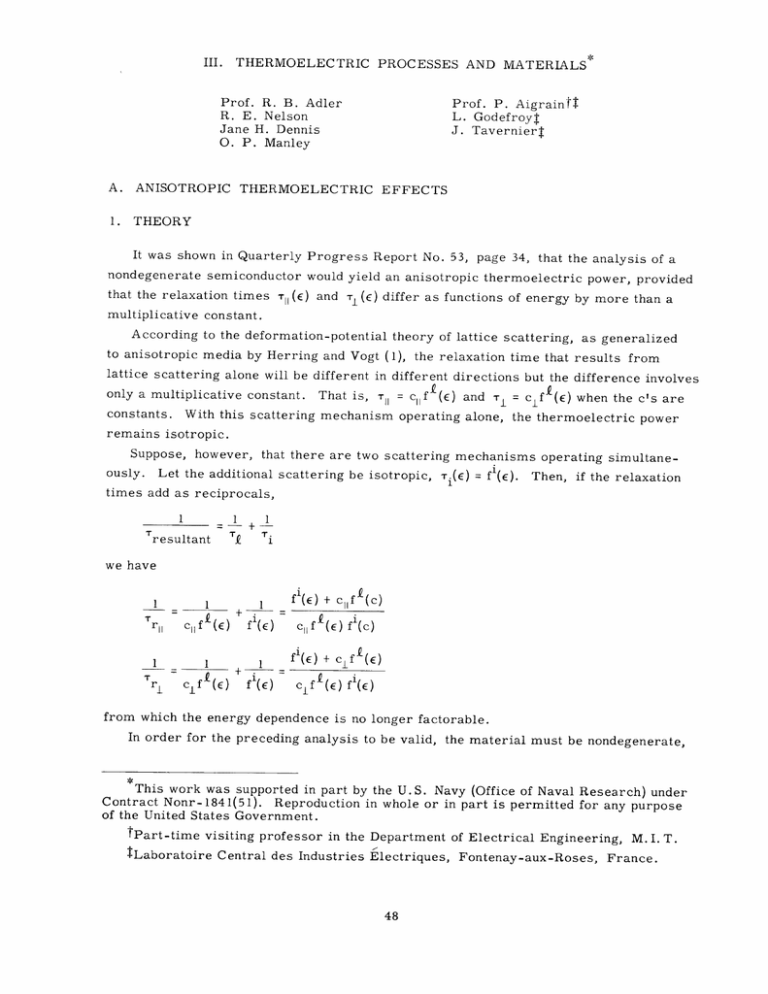
III. THERMOELECTRIC PROCESSES AND MATERIALS' Prof. R. B. Adler R. E. Nelson Jane H. Dennis O. P. Manley A. Prof. P. AigrainHt L. Godefroyf J. Tavernierl ANISOTROPIC THERMOELECTRIC EFFECTS 1. THEORY It was shown in Quarterly Progress Report No. 53, page 34, that the analysis of a nondegenerate semiconductor would yield an anisotropic thermoelectric power, provided that the relaxation times T 11 (E) and T1 (E) differ as functions of energy by more than a multiplicative constant. According to the deformation-potential theory of lattice scattering, as generalized to anisotropic media by Herring and Vogt (1), the relaxation time that results from lattice scattering alone will be different in different directions but the difference involves only a multiplicative constant. That is, T 11 = c 1f (E) and T = cf (E) when the c's are constants. With this scattering mechanism operating alone, the thermoelectric power remains isotropic. Suppose, however, that there are two scattering mechanisms operating simultaneLet the additional scattering be isotropic, T.i(E) = f'(E). Then, if the relaxation ously. times add as reciprocals, 1 1- I 1 --+ IT Tresultant i we have r,1 c1if 1 r1 (E) 1 cIf fi(E) + clf 1 1 1 T + f (E) 1 (E) fi() - (c) i c11f (E) fi(c) fi(E)+ cf f (E) (E) fi (E) from which the energy dependence is no longer factorable. In order for the preceding analysis to be valid, the material must be nondegenerate, This work was supported in part by the U.S. Navy (Office of Naval Research) under Contract Nonr-1841(51). Reproduction in whole or in part is permitted for any purpose of the United States Government. tPart-time visiting professor in the Department of Electrical Engineering, M. I. T. tLaboratoire Central des Industries Electriques, Fontenay-aux-Roses, France. (III. THERMOELECTRIC PROCESSES AND MATERIALS) and the doping must be high enough for impurity scattering to be comparable with lattice scattering. Ordinarily, this much doping would make the material degenerate. to obtain many impurities, but few free carriers. by compensation. We want One way to obtain such a condition is A bismuth-telluride crystal grown from a bismuth-rich melt with iodine doping, or a tellurium-rich melt with lead doping, would therefore be likely to exhibit an anisotropic thermoelectric power. This conclusion is being pursued. Jane H. Dennis References 1. C. Herring and E. Vogt, Transport and deformation-potential theory for manyvalley semiconductors with anisotropic scattering, Phys. Rev. 101, 944-961 (1956). 2. EXPERIMENT We have succeeded in pulling good single crystals of bismuth telluride, with dimen- sions 12 cm X 1 cm X 2 mm, from a stoichiometric melt. Crystals made in this way were carefully potted in de Khotinsky cement and cut at a very slow rate on a high-speed saw. Etching revealed cracks extending 1/4 inch from the edge of the cut. Cutting with a hot wire was tried, but such a large wire was required to carry the necessary heating power that the precision of the cut was not very high. Further attempts to solve the cutting problem are being made. Jane H. Dennis, O. P. B. TRANSPORT OF CONTACT MATERIALS IN BISMUTH TELLURIDE 1. EXPERIMENT Manley Construction of a furnace for reacting bismuth and tellurium in an inert atmosphere has been completed, and it is in use in conjunction with the crystal puller. The furnace consists of a hermetically sealed vycor tube into which a crucible containing up to 100 g of bismuth and tellurium can be inserted. The inert atmosphere is maintained inside the furnace by a continuous flow of helium at the rate of approximately 4 ft3/hr. 2. THEORY Two papers dealing with the theory of diffusion have been submitted for publication. A paper co-authored with S. A. Rice, Diffusion in Crystals'," entitled "Comments on 'Dynamical Theory of was submitted to the Physical Review. the errors in Rice's original publication (1); This paper corrects it also includes a calculation that greatly (III. THERMOELECTRIC PROCESSES AND MATERIALS) simplifies the ultimate appearance of the pair correlation functions introduced by Rice. A second paper, entitled "A Method of Evaluating Diffusion Coefficients in Crystals," was submitted to the Journal of the Physics and Chemistry of Solids. This paper recon- siders Rice's model for diffusion with the aid of an extension of Kac's theorem (2). analysis yields an activation energy which, as predicted by Zener (3), to the minimal local deformation energy. treatment, The is simply related It is also found that, in contrast with Rice's the activation energy may, in the first approximation, be calculated directly from the atomic force constants without resorting to normal-mode analysis. O. P. Manley References 1. S. A. Rice, Dynamical theory of diffusion in crystals, Phys. Rev. (1958). 112, 804 2. M. Kac, On the distribution of values of trigonometric sums with linearly independent frequencies, Am. J. Math. 65, 609 (1943). 3. C. Zener, Imperfections in Nearly Perfect Crystals (John Wiley and Sons, Inc., New York, 1952), p. 289. C. THERMAL CONDUCTIVITY STUDIES 1. THEORY The Tavernier theory of thermal conductivity (1) predicts a proportionality relation between thermal conductivity and powers of the parameters Tf, M, p, E, T. For a given crystal structure, the proportionality constant in the theory has previously been obtainable only from experimental data. Now the theoretical interpretation of the constant is being considered. Knowledge of the anharmonic terms in the crystal potential energy is necessary for the development of this theory. is being sought in terms of macroscopic parameters, An expression for the constant such as Gruneisen's compressibility, and so forth, but results are not yet available. 2. constant, EXPERIMENT Equipment for the thermal-diffusivity method of measuring heat conductivity is now available (see Fig. III-1). The first measurements were made at room temperature in high vacuum on germanium and silicon samples. 0. 6 watt/oC cm for silicon and germanium, Values of 1 watt/oC cm and respectively, have been observed, but the precision of the measurements on these high-conductivity materials is very poor. This work is being performed at Laboratoire Central des Industries Electriques, Fontenay-aux-Roses, France. (III. THERMOELECTRIC ROTATION PROCESSES AND MATERIALS) PERIOD, 2 MINUTES SAMPLE I__________ Fig. III-1. Thermal diffusivity method of measuring heat conductivity. The apparatus is now being used for thermal-conductivity measurements on mixed crystals in the selenium-tellurium system. The crystals are prepared by melting the desired quantities of the elements in vacuum-sealed tubes. The first samples purified by zone melting in sealed tubes are now available. Measurements of the resistivity p and thermoelectric power Q of these mixed crystals at room temperature have yielded the results given in Table III-1. Table III- 1. Type Composition p Q (atomic percentage) (ohm cm) (4v/o C) 20o Se 0.8 500 p 30% Se 5 600 p 40% Se 50 800 p With 0. 02 watt/°C cm for the thermal conductivity of tellurium, Tavernier's theory -3 shows that thermal conductivities of approximately 10 watt/°C cm can be obtained for such mixed crystals. The reason for interest in solid solutions in the selenium-tellurium system for thermoelectric applications is apparent from these initial results. Other mixed crystals with low percentages of selenium (less then 20 per cent) are being prepared. J. Tavernier References Report No. 54, 1. P. Aigrain, Thermal conductivity studies, Quarterly Progress 4 9 . p. 1959, 15, July M.I.T., Electronics, of Laboratory Research

